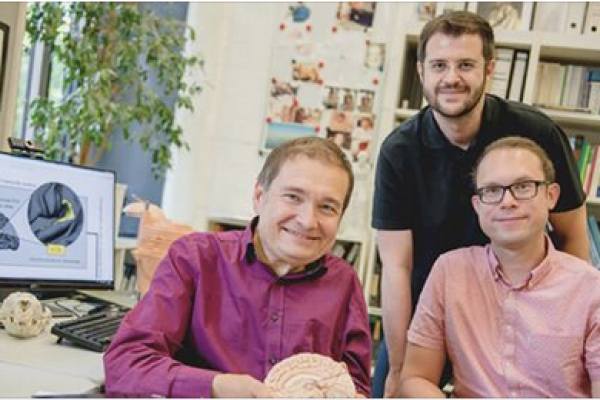2018-07-11

We understand language primarily due to our left hemisphere, which is dominant for linguistic processes. The asymmetry between the left and right hemispheres is easily demonstrated during so-called dichotic listening: When different syllables are presented to either ear, such as "pa" to the left ear and "ba" to the right ear, most people report that they heard the "ba". That is because right ear possesses a more direct pathway to the left, language dominant hemisphere. The effect is also reflected in a speed difference between the left and right hemisphere: Measuring the EEG during dichotic listening reveals faster processing in the left compared to the right hemisphere. But why is the left hemisphere faster? The answer to this question was often believed to lie within a brain region called "Planum temporale", which is bigger on the left than the right hemisphere. Importantly, the left Planum temporale possesses a higher number of neural connections than the right on. This microstructural asymmetry might solve the mystery about the left hemispheric speed advantage. Hence, we tested if there is a direct relation between the processing speed and microstructure in a large sample of almost 100 human participants. Using advanced imaging methods, we measured the density of neural connections of the Planum temporale. Additionally, the processing speed was measured via EEG during dichotic listening. Our results showed that participants with a high density of neural connections in the left planum temporale indeed showed faster processing speed. This finding unreveals a key mechanism for the question why the left hemisphere is so important for language: The high number of neural connections in the left Planum temporale possibly enables a higher precision in the communication between neurons, which in turn leads to faster processing. This superiority in microstructure might be a crucial part of why the left hemispheric became specialized for language.

We understand language primarily due to our left hemisphere, which is dominant for linguistic processes. The asymmetry between the left and right hemispheres is easily demonstrated during so-called dichotic listening: When different syllables are presented to either ear, such as "pa" to the left ear and "ba" to the right ear, most people report that they heard the "ba". That is because right ear possesses a more direct pathway to the left, language dominant hemisphere. The effect is also reflected in a speed difference between the left and right hemisphere: Measuring the EEG during dichotic listening reveals faster processing in the left compared to the right hemisphere. But why is the left hemisphere faster? The answer to this question was often believed to lie within a brain region called "Planum temporale", which is bigger on the left than the right hemisphere. Importantly, the left Planum temporale possesses a higher number of neural connections than the right on. This microstructural asymmetry might solve the mystery about the left hemispheric speed advantage. Hence, we tested if there is a direct relation between the processing speed and microstructure in a large sample of almost 100 human participants. Using advanced imaging methods, we measured the density of neural connections of the Planum temporale. Additionally, the processing speed was measured via EEG during dichotic listening. Our results showed that participants with a high density of neural connections in the left planum temporale indeed showed faster processing speed. This finding unreveals a key mechanism for the question why the left hemisphere is so important for language: The high number of neural connections in the left Planum temporale possibly enables a higher precision in the communication between neurons, which in turn leads to faster processing. This superiority in microstructure might be a crucial part of why the left hemispheric became specialized for language.